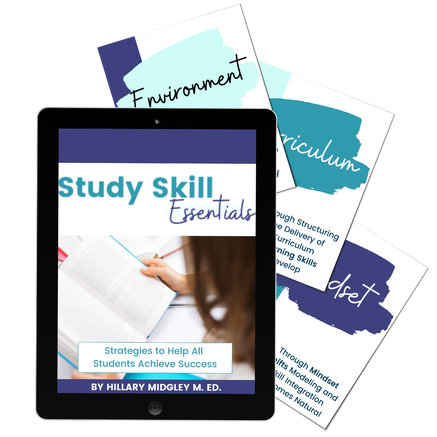5 Most Common Teacher Modeling Mistakes You're Making Every Day
Whether you are teaching your students a new class procedure or a new math concept, most teachers know that modeling is the most effective way to teach.
Yet the skill of how to model is somehow overlooked in our teacher training.
Many teachers assume that modeling for students just means showing them how to do it. I do it – we do it – you do it is a philosophy I frequently hear.
And yes that’s true, but exactly how are you modeling?Whether you are teaching your students a new class procedure or a new math concept, most teachers know that modeling is the most effective way to teach.
Yet the skill of how to model is somehow overlooked in our teacher training.
Many teachers assume that modeling for students just means showing them how to do it. I do it – we do it – you do it is a philosophy I frequently hear.
And yes that’s true, but exactly how are you modeling?
Yet the skill of how to model is somehow overlooked in our teacher training.
Many teachers assume that modeling for students just means showing them how to do it. I do it – we do it – you do it is a philosophy I frequently hear.
And yes that’s true, but exactly how are you modeling?Whether you are teaching your students a new class procedure or a new math concept, most teachers know that modeling is the most effective way to teach.
Yet the skill of how to model is somehow overlooked in our teacher training.
Many teachers assume that modeling for students just means showing them how to do it. I do it – we do it – you do it is a philosophy I frequently hear.
And yes that’s true, but exactly how are you modeling?
When I first started teaching, I don’t remember anyone explaining or showing me how to model for students effectively.
In fact, I’d say my knowledge on the subject now, comes from not only my 20 years working with kids but also my own experience as a learner.
In this post, I’m going to share with you 5 mistakes most teachers make when modeling for their students. My hope is to bring light to an essential teaching skill and provide guidance on improving that skill.
In fact, I’d say my knowledge on the subject now, comes from not only my 20 years working with kids but also my own experience as a learner.
In this post, I’m going to share with you 5 mistakes most teachers make when modeling for their students. My hope is to bring light to an essential teaching skill and provide guidance on improving that skill.
Modeling Mistake #1
Giving Too Little Information
Too often I see teachers model a skill or procedure and not provide enough information for students.
While teachers tend to cover what to do, they fail to cover why it needs to be done a particular way.
While the depth of your explanation will vary depending on the age range of your students, you still must give a sufficient explanation.
When your students understand why they should perform a routine a certain way, they will be more aware of what they are doing and more inclined to do it.
For example, one of my procedures for the start of class is having students take out the materials needed and to have students put all extra materials under their chair.
In order to gain more compliance and have to give fewer reminders, I explain to students why I insist on this procedure.
1) Having extra materials out of the way will give them more room to work on their desks.
2) Having materials under their chair will help eliminate distractions so they can focus.
3) Placing materials under the chair and not in the isle keeps their things protected from getting trampled.
4) It keeps people from tripping over their things.
I like to add if I trip over their materials and have to miss out on snowmachining season with a broken ankle then I will be one unhappy Ms. Midgley. This always gets a giggle and more compliance.
Too often I see teachers model a skill or procedure and not provide enough information for students.
While teachers tend to cover what to do, they fail to cover why it needs to be done a particular way.
While the depth of your explanation will vary depending on the age range of your students, you still must give a sufficient explanation.
When your students understand why they should perform a routine a certain way, they will be more aware of what they are doing and more inclined to do it.
For example, one of my procedures for the start of class is having students take out the materials needed and to have students put all extra materials under their chair.
In order to gain more compliance and have to give fewer reminders, I explain to students why I insist on this procedure.
1) Having extra materials out of the way will give them more room to work on their desks.
2) Having materials under their chair will help eliminate distractions so they can focus.
3) Placing materials under the chair and not in the isle keeps their things protected from getting trampled.
4) It keeps people from tripping over their things.
I like to add if I trip over their materials and have to miss out on snowmachining season with a broken ankle then I will be one unhappy Ms. Midgley. This always gets a giggle and more compliance.
Modeling Mistake #2
Modeling Only a Skill or Procedure and not Both
This one I often see from both sides. A teacher is great at modeling for students how to perform a new math skill. But they fail to model a new class procedure.
And vise-versa, a teacher who is great at modeling classroom management procedures doesn’t think to model note-taking skills.
Your students need your guidance in both.
What exactly should you be modeling for your students? The short answer is, EVERYTHING.
This one I often see from both sides. A teacher is great at modeling for students how to perform a new math skill. But they fail to model a new class procedure.
And vise-versa, a teacher who is great at modeling classroom management procedures doesn’t think to model note-taking skills.
Your students need your guidance in both.
What exactly should you be modeling for your students? The short answer is, EVERYTHING.
Modeling Mistake #3
Not Voicing Your Thought Process
Many teachers tend to focus their efforts on modeling what to do. We already addressed helping students understand the why, but we must also show them how.
How exactly do you go from point A to point B? While you may be showing them physically on the board, you must also model for them the process that happens in your mind.
We can’t exactly show our students what’s in our mind, but we can voice our thought process out loud so they can follow along.
The steps we take in our mind are often the crucial connectors that make understanding easier. When students struggle to see the big picture and make connections, it is usually the thought process that is struggling. We as teachers can model for students how we make connections.
Many teachers tend to focus their efforts on modeling what to do. We already addressed helping students understand the why, but we must also show them how.
How exactly do you go from point A to point B? While you may be showing them physically on the board, you must also model for them the process that happens in your mind.
We can’t exactly show our students what’s in our mind, but we can voice our thought process out loud so they can follow along.
The steps we take in our mind are often the crucial connectors that make understanding easier. When students struggle to see the big picture and make connections, it is usually the thought process that is struggling. We as teachers can model for students how we make connections.
Modeling Mistake #4
Lowering Expectations
Once you start lowering expectations, the quality of student work and classroom management starts to head downhill.
You model for students the expectation. You should expect nothing less than the expectation you set. If your students are putting forth the effort but are struggling to meet the expectation, then you know that you need to revisit your modeling techniques and try again.
For students who struggle to meet the academic expectation, you should be providing an appropriate level of support. You do not lower the bar for them (you don’t do it for them either). You support them so they too can reach the expectation.
Once you start lowering expectations, the quality of student work and classroom management starts to head downhill.
You model for students the expectation. You should expect nothing less than the expectation you set. If your students are putting forth the effort but are struggling to meet the expectation, then you know that you need to revisit your modeling techniques and try again.
For students who struggle to meet the academic expectation, you should be providing an appropriate level of support. You do not lower the bar for them (you don’t do it for them either). You support them so they too can reach the expectation.
Modeling Mistake #5
Not Modeling Study Skills
You guessed it – I saved the big one for last. No matter what class you teach... What subject you teach... You must model study skills for your students.
Your students will not be able to learn your content if you don’t provide them the skills to do so. How do you teach study skills? You model them, of course!
Prioritizing, organizing, time management, textbook skills, note-taking skills, project management skills are all skills you should be modeling for your students. And believe it or not, it is possible to integrate these skills into your regular instruction without taking time away from your content.
Curious to know how? I’m so glad you asked! That is exactly what my Study Skill Essential Training Program is all about: How to integrate study skills into your everyday teaching without losing instruction time! Click the link to check it out: How to Integrate Study Skills, Professional Development for Teachers.
You guessed it – I saved the big one for last. No matter what class you teach... What subject you teach... You must model study skills for your students.
Your students will not be able to learn your content if you don’t provide them the skills to do so. How do you teach study skills? You model them, of course!
Prioritizing, organizing, time management, textbook skills, note-taking skills, project management skills are all skills you should be modeling for your students. And believe it or not, it is possible to integrate these skills into your regular instruction without taking time away from your content.
Curious to know how? I’m so glad you asked! That is exactly what my Study Skill Essential Training Program is all about: How to integrate study skills into your everyday teaching without losing instruction time! Click the link to check it out: How to Integrate Study Skills, Professional Development for Teachers.
This post was originally written by Hillary Midgley and published at Study Skills Unleashed
You May Also Like...
Let's Connect...

Welcome! I'm Hillary Midgley, a veteran 6th grade teacher.
I create educational materials and develop curriculum for other teachers. I specialize in teaching students how to learn through my Study Skills Curriculum. I have established fundamental classroom systems and structures for teachers to help them streamline their classroom. And my passion is teaching ancient history through engaging activities with foundations in academic skills. Here you will find resources on all of these topics and more. Learn more about me here.
|








